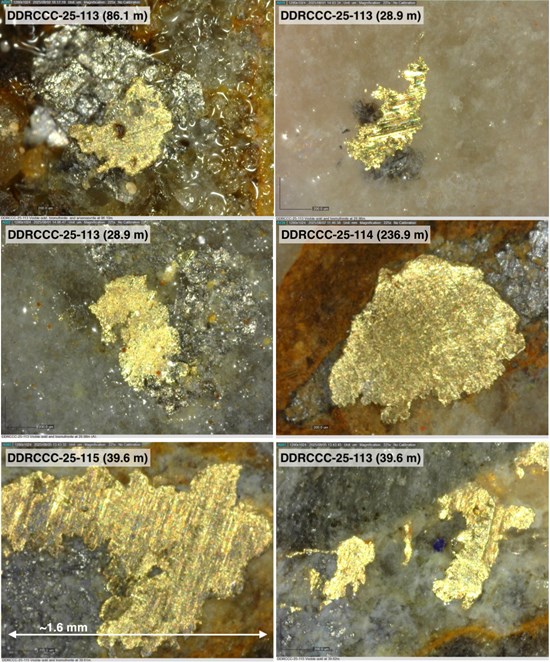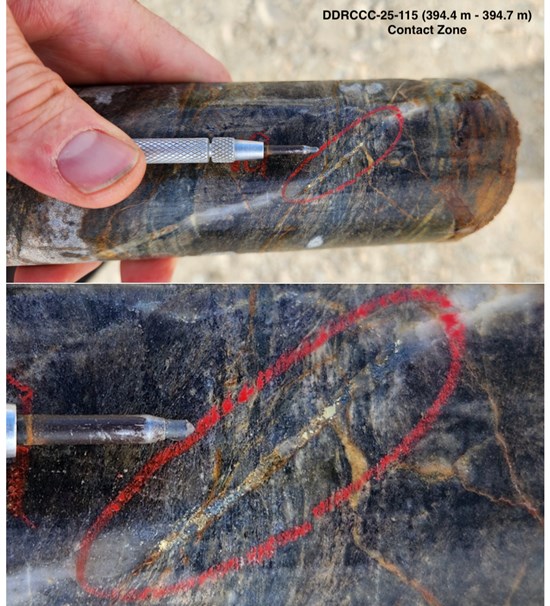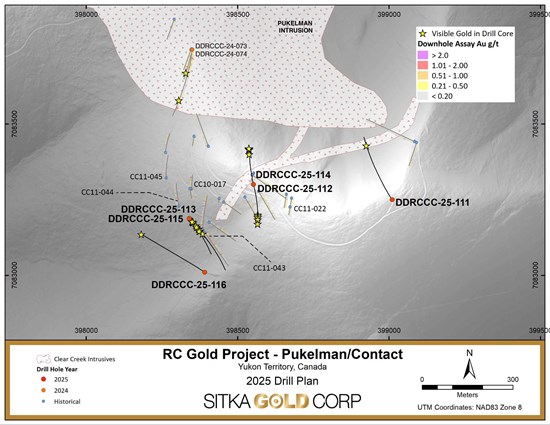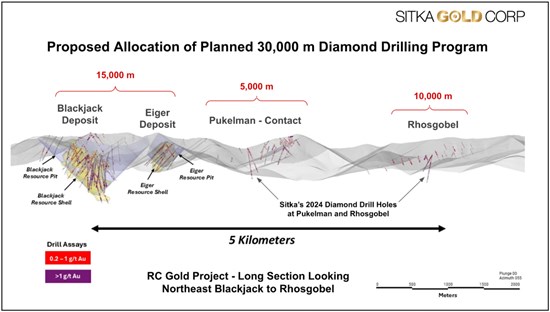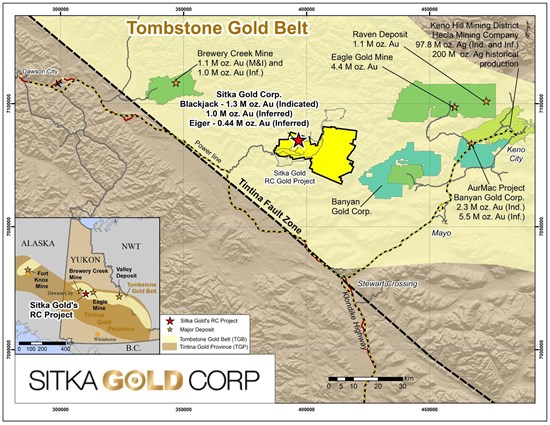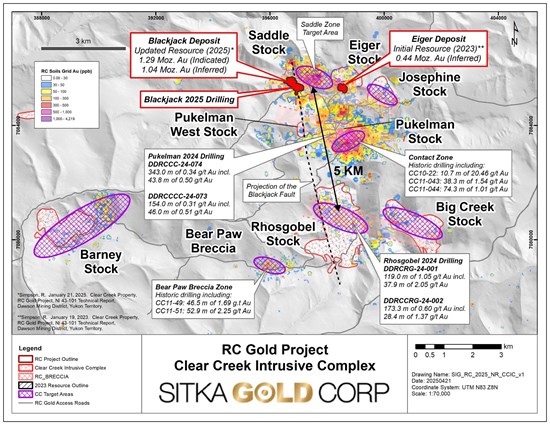
August 19, 2025
Sitka Gold Corp. (TSXV: SIG) (FSE: 1RF) (OTCQB: SITKF) ("Sitka" or the "Company") is pleased to announce that multiple occurrences of visible gold have been observed, beginning near surface, in the first six drill holes to be completed by the Company at the Contact zone. Visible gold has now been observed in the drill core from every target that has been drilled within the Clear Creek Intrusive Complex so far this year, including Blackjack, Saddle, Eiger and Rhosgobel. Up to 5,000 metres of drilling is currently underway at the Contact-Pukelman zone (see Figures 3, 4 and 6) as part of the fully funded 30,000 metre diamond drill program currently underway at Sitka's 100% owned, road accessible RC Gold Project located in the Yukon's prolific Tombstone Gold Belt. Over 25,000 metres of drilling has been completed at RC Gold this year where drilling has focused on growing the Blackjack and Eiger deposits, expanding the mineralized footprint of the Saddle zone, and testing the potential of the Rhosgobel, Contact-Pukelman and Bear Paw targets to host additional intrusion-related gold deposits. Four drill rigs are currently operating on the Project with two rigs at Pukelman, one rig at Rhosgobel and one rig at Bear Paw (see Figure 6) with assay results currently pending for 52 holes.
- Visible gold observed in first six diamond drill holes drilled at the Contact zone
- Drilling to date has traced mineralization along a strike of approximately 900 m and to a depth of approximately 430 m from surface at the Contact zone
- Visible gold has now been observed in drill core from all five targets drilled within the Clear Creek Intrusive Complex this year
- First drilling completed since 2010/2011 that produced historical intersections in Contact zone of 38.3 m of 1.54 g/t gold, 74.3 m of 1.01 g/t gold and 43.4 m of 1.20 g/t gold in Holes CC11-043, 044, 045 respectively and 10.7 m of 20.46 g/t gold in CC10-22
- Six holes totalling 2,172 m completed as part of the ongoing 5,000 m of drilling planned at Contact-Pukelman target
- Drilling has also recently commenced at the Bear Paw target
- Results are currently pending for all holes drilled at Contact-Pukelman along with holes completed across Blackjack, Saddle, Eiger, Rhosgobel and Bear Paw
- Over 25,000 metres of the ongoing 30,000 m planned drill program completed with assays currently pending for 52 holes
"The Contact zone is now the fifth target drilled by Sitka Gold in 2025 to yield multiple occurrences of visible gold within the core of the Clear Creek Intrusive Complex," said Cor Coe, CEO and Director of Sitka Gold. "The widespread and robust gold mineralization being intersected in our drilling across this area continues to demonstrate that the RC Gold project is a unique gold camp with multiple intrusions that display the potential to host several multi-million ounce gold deposits within this relatively small 3 by 5 kilometre core area. With an existing multi-million ounce gold resource open for expansion and numerous other high-quality targets within the 431 square kilometre land package, RC Gold is quickly emerging as the foundation of a potential new mining district in the Yukon."
Figure 1: Examples of coarse visible gold (VG) observed in drill core at the Contact Zone. Recent drilling at the Contact Zone has intersected VG in all six holes completed so far this year, including the largest VG particles observed on the property in drill core to date (scale is the same for all pictures).
To view an enhanced version of this graphic, please visit:
https://images.newsfilecorp.com/files/6144/263028_3e4ae39d74986bb2_001full.jpg
Figure 2: Example of large particles of visible gold seen within a quartz vein in metasedimentary rock in the drill core of DDRCCC-25-115 from 39.4 to 39.7 m length drilled at the Contact zone.
To view an enhanced version of this graphic, please visit:
https://images.newsfilecorp.com/files/6144/263028_3e4ae39d74986bb2_002full.jpg
Contact-Pukelman Target
Six holes totalling 2,172 metres have been completed as part of the ongoing 5,000 metres of drilling planned at the Contact-Pukelman target. Drilling intersected broad intervals of strongly altered metasediments cut by several quartz monzonite, and biotite-feldspar porphyritic dykes, along with abundant, cm scale, sheeted quartz veins. Visible gold was observed in the sheeted quartz veins and was often associated with arsenopyrite, bismuthinite, and minor scheelite (see Figures 1 and 2).
Sitka's 2025 drill program is planned to expand the mineralized footprint of the Contact zone, test the zone with oriented diamond drill core to better understand controls on the mineralization and test the linkage between the metasedimentary and intrusion hosted mineralization of the Contact and Pukelman zones. The Contact zone was previously drilled in 2010 and 2011 with 1,660 metres in 12 holes of reverse circulation drilling and 254 metres in 2 holes of diamond drilling (see Table 1) and encountered significant mineralization in quartz veining within metasedimentary rocks up to 450 metres south of the Pukelman intrusion. Current drilling to date has traced gold mineralization across a lateral extent of approximately 900 metres x 650 metres and from surface to a depth of approximately 430 metres (see Figure 3 and Table 1). While this is an encouraging indicator of the potential size of this target, the Company cautions that additional drilling and assay results are required to confirm the extent and continuity of gold mineralization within this area.
* While visible gold observations are very encouraging and confirm the presence of gold mineralization, they are not intended to imply potential gold grades. Gold assays will be published after they are received from the lab for mineralized intervals in which visible gold particles were noted.
Figure 3: A location map of the Pukelman/Contact area showing the location of drill holes DDRCCC-25-111 to -116. Drilling to date has traced gold mineralization across a lateral extent of approximately 900 m x 650 m and from surface to a depth of approximately 430 m.
To view an enhanced version of this graphic, please visit:
https://images.newsfilecorp.com/files/6144/263028_3e4ae39d74986bb2_003full.jpg
Table 1: Highlights of reverse circulation drilling from 2010 and 2011 at the Contact zone

To view an enhanced version of this graphic, please visit:
https://images.newsfilecorp.com/files/6144/263028_sitkatbl108192025.jpg
*Intervals are drilled core length, as insufficient drilling has been completed at this time to determine true widths.
(a) O'Brien, 2010; Assessment Report, 2010 Diamond Drilling Program, Clear Creek Property (Assessment report 095539)
(b) Shutty, 2011; Assessment Report, 2011 Exploration Program, Clear Creek Property (Assessment Report 095984)
Figure 4: Long Section showing target areas within the Clear Creek Intrusive Complex (CCIC), from the Blackjack deposit to the Rhosgobel target and the proposed drilling metres that were allocated as part of the 30,000 metre diamond drilling program planned for 2025. Visible gold has now been observed in drill core from all of the targets drilled this year within the CCIC.
To view an enhanced version of this graphic, please visit:
https://images.newsfilecorp.com/files/6144/263028_3e4ae39d74986bb2_004full.jpg
Figure 5: Regional map of the RC Gold Project located in the western portion of Yukon's prolific Tombstone Gold Belt.
To view an enhanced version of this graphic, please visit:
https://images.newsfilecorp.com/files/6144/263028_3e4ae39d74986bb2_005full.jpg
Figure 6: A plan map of the Clear Creek Intrusive Complex (CCIC) showing the updated resource areas at Blackjack and Eiger, and the six additional areas that have drill targets indicated by the mauve hatched areas. The map highlights the numerous drill targets that Sitka has outlined within the CCIC which all are connected by the road network on the project and occur in an area measuring five (5) km north-south and twelve (12) km east-west. Additional areas highlighted by strong gold in soil anomalies are being advanced to the drill ready stage with additional geological work in 2025.
To view an enhanced version of this graphic, please visit:
https://images.newsfilecorp.com/files/6144/263028_3e4ae39d74986bb2_006full.jpg
About the Flagship RC Gold Project
Sitka's 100% owned RC Gold Project consists of a 431 square kilometre contiguous district-scale land package located in the heart of Yukon's Tombstone Gold Belt. The project is located approximately 100 kilometres east of Dawson City, which has a 5,000 foot paved runway, and is accessed via a secondary gravel road from the Klondike Highway which is usable year-round and is an approximate 2 hour drive from Dawson City. It is the largest consolidated land package strategically positioned mid-way between the Eagle Gold Mine and the past producing Brewery Creek Gold Mine.
The RC Gold Project now has pit-constrained mineral resources that are contained in two zones: the Blackjack and Eiger gold deposits with 1,291,000 ounces of gold in 39,962,000 tonnes grading 1.01 g/t gold in an indicated category and 1,044,000 ounces of gold in 34,603,000 tonnes grading 0.94 g/t in an inferred category at Blackjack and 440,000 ounces of gold in 27,362,000 tonnes grading 0.50 g/t gold in an inferred category at Eiger. These resource estimate numbers are supported by the recently updated technical report for RC Gold, prepared in accordance with NI 43-101 standards, entitled "Clear Creek Property, RC Gold Project NI 43-101 Technical Report Dawson Mining District, Yukon Territory", prepared by Ronald G. Simpson, P. Geo., of GeoSim Services Inc. with an effective date of January 21, 2025. This report is available on SEDAR+ (http://www.sedarplus.ca) and on the Company's website (www.sitkagoldcorp.com).
Both of these deposits begin at surface, are potentially open pit minable and amenable to heap leaching, with initial bottle roll tests indicating that the gold is not refractory and has high gold recoveries of up to 94% with minimal NaCN consumption (see News Release July 13, 2022).
As of the end of 2024, the Company has drilled 72 diamond drill holes into this system for a total of approximately 25,136 metres. Other targets drilled to date include the Saddle, Josephine, Rhosgobel and Pukelman zones. The resource expansion drilling in 2023 at Blackjack produced results of up to 219.0 metres of 1.34 g/t gold including 124.8 metres of 2.01 g/t gold and 55.0 metres of 3.11 g/t gold in drill hole DDRCCC-23-047 (see news release dated September 26, 2023) and in 2024 results of up to 678.1 metres of 1.04 g/t gold starting from surface in DDRCCC-24-068, including 409.5 metres of 1.36 g/t gold, 93.0 metres of 2.57 g/t gold and 5.5 metres of 17.59 g/t gold (see news release dated October 21, 2024). Results from DDRCCC-25-075, completed during winter drilling in 2025, produced the best high-grade intercepts drilled to date at Blackjack, returning 352.8 metres of 1.55 g/t gold including 108.9 metres of 3.27 g/t gold and 45.0 metres of 4.52 g/t gold (see news release dated April 22, 2025).
A planned 30,000 metre diamond drilling program for 2025 is currently underway at RC Gold.
RC Gold Deposit Model
Exploration on the Property has mainly focused on identifying an intrusion-related gold system ("IRGS"). The property is within the Tombstone Gold Belt which is the prominent host to IRGS deposits within the Tintina Gold Province in Yukon and Alaska. Notable deposits from the belt include: Fort Knox Mine in Alaska with current Proven and Probable Reserves of 230 million tonnes at 0.3 g/t Au (2.471 million ounces; Sims 2018)(1); Eagle Gold Mine with current Measured and Indicated Resources of 233 million tonnes at a grade of 0.57 g/t Au at the Eagle Main Zone (4.303 million ounces; Harvey et al, 2022)(2); the Brewery Creek deposit with current Indicated Mineral Resource of 22.2 million tonnes at a gold grade of 1.11 g/t (0.789 million ounces; Hulse et al. 2020)(3); the AurMac Project with an Inferred Mineral Resource of 347.49 million tonnes grading 0.63 gram per tonne gold (7.00 million ounces)(4) and the Valley Deposit, with a current Measured and Indicated Mineral Resource of 7.94 million oz gold at 1.21 g/t and an additional Inferred Mineral Resource of 0.89 million oz at 0.62 g/t gold(5), and the Raven deposit with an inferred mineral resource of 1.1 million oz (19.96 million tonnes at 1.67 g/t gold)(6). The QP has been unable to verify the information regarding the above resource estimations and the information is not necessarily indicative of the mineralization on the property that is the subject of the disclosure.
(1) Sims J. Fort Knox Mine Fairbanks North Star Borough, Alaska, USA National Instrument 43-101 Technical Report. June 11, 2018. https://s2.q4cdn.com/496390694/files/doc_downloads...
(2) Harvey N., Gray P., Winterton J., Jutras M., Levy M.,Technical Report for the Eagle Gold Mine, Yukon Territory, Canada. Victoria Gold Corp. December 31, 2022. https://vgcx.com/site/assets/files/6534/vgcx_-_202...
(3) Hulse D, Emanuel C, Cook C. NI 43-101 Technical Report on Mineral Resources. Gustavson Associates. May 31, 2020. https://minedocs.com/22/Brewery-Creek-PEA-01182022...
(4) Thornton T., Jutras M., Malhotra D. Technical Report Aurmac Property Mayo Mining District, Yukon Territory, Canada. JDS Energy and Mining Inc. February 6, 2024. https://banyangold.com/site/assets/files/5251/bany...
(5)https://snowlinegold.com/2025/05/15/snowline-gold-...
(6) Jutras, M. 2022. Technical Report on the Raven Mineral Deposit, Mayo Mining District Yukon Territory, Canada, prepared for Victoria Gold Corp and filed on SEDAR (www.sedar.com) with an effective date of September 15, 2022
Upcoming Events
Sitka Gold will be attending and/or presenting at the following events*:
- Precious Metals Summit, Beaver Creek, Colorado: September 9 - 12, 2025
- Yukon Geoscience Forum, Whitehorse, YT: November 16 - 19, 2025
- Swiss Mining Institute, Zürich, Switzerland: November 19 - 22, 2025
*All events are subject to change.
About Sitka Gold Corp.
Sitka Gold Corp. is a well-funded mineral exploration company headquartered in Canada. The Company is managed by a team of experienced industry professionals and is focused on exploring for economically viable mineral deposits with its primary emphasis on gold, silver and copper mineral properties of merit. Sitka is currently advancing its 100% owned, 431 square kilometre flagship RC Gold Project located within the Tombstone Gold Belt in the Yukon Territory. The Company is also advancing the Alpha Gold Project in Nevada and currently has drill permits for its Burro Creek Gold and Silver Project in Arizona and the Coppermine River Project in Nunavut, all of which are 100% owned by the Company.
*For more detailed information on the Company's properties please visit our website at www.sitkagoldcorp.com.
The scientific and technical content of this news release has been reviewed and approved by Gilles Dessureau, P.Geo., V.P. Exploration of the Company, and a Qualified Person (QP) as defined by National Instrument 43-101.
ON BEHALF OF THE BOARD OF DIRECTORS OF
SITKA GOLD CORP.
"Donald Penner"
President and Director
For more information contact:
| Donald Penner President & Director 778-212-1950 dpenner@sitkagoldcorp.com | or | Cor Coe CEO & Director 604-817-4753 ccoe@sitkagoldcorp.com |
Neither TSX Venture Exchange nor its Regulation Services Provider (as that term is defined in policies of the TSX Venture Exchange) accepts responsibility for the adequacy or accuracy of this release.
Cautionary and Forward-Looking Statements
This release includes certain statements and information that may constitute forward-looking information within the meaning of applicable Canadian securities laws. Forward-looking statements relate to future events or future performance and reflect the expectations or beliefs of management of the Company regarding future events. Generally, forward-looking statements and information can be identified by the use of forward-looking terminology such as "intends" or "anticipates", or variations of such words and phrases or statements that certain actions, events or results "may", "could", "should", "would" or "occur". This information and these statements, referred to herein as "forward‐looking statements", are not historical facts, are made as of the date of this news release and include without limitation, statements regarding discussions of future plans, estimates and forecasts and statements as to management's expectations and intentions and the Company's anticipated work programs.
These forward‐looking statements involve numerous risks and uncertainties and actual results might differ materially from results suggested in any forward-looking statements. These risks and uncertainties include, among other things, market uncertainty and the results of the Company's anticipated work programs.
Although management of the Company has attempted to identify important factors that could cause actual results to differ materially from those contained in forward-looking statements or forward-looking information, there may be other factors that cause results not to be as anticipated, estimated or intended. There can be no assurance that such statements will prove to be accurate, as actual results and future events could differ materially from those anticipated in such statements. Accordingly, readers should not place undue reliance on forward-looking statements and forward-looking information. Readers are cautioned that reliance on such information may not be appropriate for other purposes. The Company does not undertake to update any forward-looking statement, forward-looking information or financial out-look that are incorporated by reference herein, except in accordance with applicable securities laws. We seek safe harbor.
SIG:CA
The Conversation (0)
26 December
Rick Rule, Ed Steer, Vince Lanci and More — Our Top 5 Interviews of the Year
2025 was a breakout year for gold and silver, and throughout its twists and turns the Investing News Network (INN) turned to experts for help navigating the markets.The INN team spoke with dozens of industry insiders over the course of the year, spending time with seasoned professionals who can... Keep Reading...
25 December
Jeffrey Christian: Gold, Silver at Record Prices, Expect Spikes Higher in 2026
Jeffrey Christian, managing partner at CPM Group, shares his outlook for gold and silver in 2026, explaining why he expects higher prices for the metals. "We think that 2026 is going to be a more hostile environment than 2025, and that will cause investors to buy more gold and silver. So we're... Keep Reading...
24 December
What Was the Highest Price for Gold?
Gold has long been considered a store of wealth, and the price of gold often makes its biggest gains during turbulent times as investors look for cover in this safe-haven asset.The 21st century has so far been heavily marked by episodes of economic and sociopolitical upheaval. Uncertainty has... Keep Reading...
24 December
Blackrock Silver Announces C$15 Million Strategic Investment by Two Cornerstone Purchasers
Blackrock Silver Corp. (TSXV: BRC,OTC:BKRRF) (OTCQX: BKRRF) (FSE: AHZ0) ("Blackrock" or the "Company") is pleased to announce a non-brokered private placement (the "Offering") of up to 13,636,363 units (the "Units") at a price of C$1.10 per Unit for gross proceeds of up to C$15,000,000. Each... Keep Reading...
24 December
Gold Price Hits New Record, Breaks US$4,500; Silver, Platinum Also at All-time Highs
Gold marked a new price milestone on Tuesday (December 23), continuing its record-breaking 2025 run. The spot price rose as high as US$4,511.83 per ounce, hitting that point at 4:04 p.m. PST. Don't forget to follow us @INN_Resource for real-time updates!Securities Disclosure: I, Charlotte... Keep Reading...
23 December
From Gold Coins to Copper Tools: Unique Festive Gifts for the Metals Investor
With pumpkin spice in the air, thoughts are turning to the biggest event of the year… No, not the curling championships — Black Friday and the start of the gifting season.Here at the Investing News Network, our team aims to provide relevant information to help readers make informed investment... Keep Reading...
Latest News
Interactive Chart
Latest Press Releases
Steadright Grants Stock Options
24 December
Silverco Confirms No Material Change
24 December
Related News
TOP STOCKS
American Battery4.030.24
Aion Therapeutic0.10-0.01
Cybin Corp2.140.00
